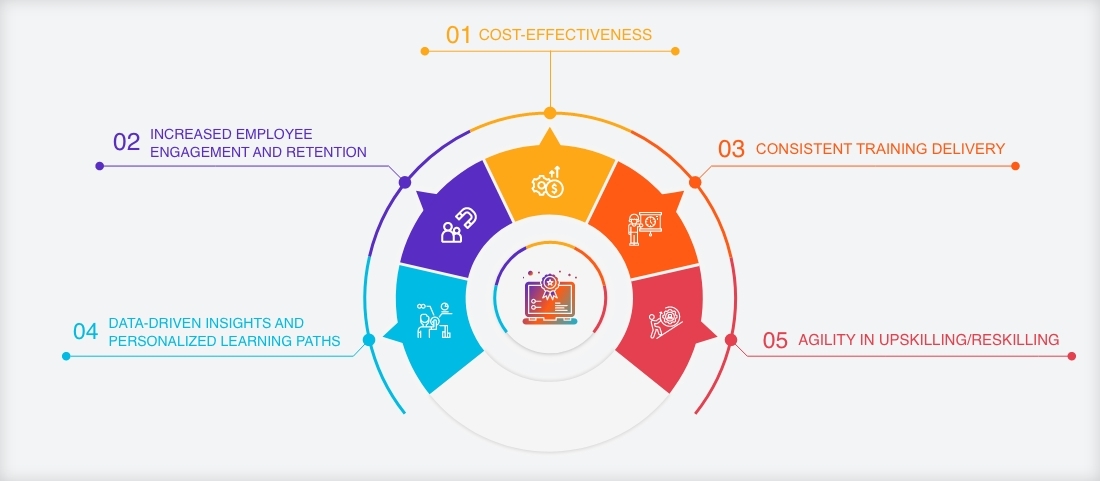Building your digital academy: Strategies, benefits, and best practices
Published April 02, 2024. 6 min readIt's more important than ever for organizations today to prioritize continuous learning and skill development. By investing in their employees' growth and equipping them with the right knowledge and expertise, companies can gain a significant competitive edge. Innovation thrives, operational efficiency soars, and a future-ready workforce emerges, ready to tackle any challenge that comes their way.Leading organizations are recognizing this pivotal need and turning to digital academies to revolutionize their internal training and learning initiatives. A digital academy is a cutting-edge online learning platform that harnesses the power of educational technology (EdTech) and e-learning platform development. It delivers an engaging, interactive, and self-paced training experience tailored specifically for employees. Most importantly, a digital academy unlocks new opportunities for professional growth and career advancement, empowering employees to reach their full potential and contribute to the organization's success in meaningful ways.

Strategies for building an effective digital academy
Building an effective digital academy is a game-changer for organizations looking to empower their employees with the knowledge and skills they need to drive innovation and operational excellence. But where do you start? Let's dive into some key strategies that will set you on the path to success:
- Start with a deep understanding: Before you even begin designing your digital academy, it's crucial to take a step back and conduct a comprehensive training needs assessment. This isn't just about checking boxes – it's about truly understanding the specific skill gaps, knowledge deficiencies, and professional development areas that your employees are facing. Only by gaining these invaluable insights can you develop online courses that are targeted, relevant, and directly address the pain points and goals of your organization.
- Choose the right learning management system (LMS): At the core of your digital academy lies a robust LMS – the powerful platform that will be the central hub for hosting, delivering, and managing your online courses. However, not all LMS solutions are created equal. As you evaluate your options, keep an eye out for features that will ensure a seamless and engaging learning experience for your employees, such as scalability, integration capabilities, mobile responsiveness, and robust reporting features.
- Craft engaging and interactive courses: Effective online courses are more than just a one-way delivery of content. They foster active learning, engagement, and knowledge retention. To achieve this, leverage a variety of multimedia formats, such as videos, interactive simulations, case studies, and gamification elements, to cater to different learning styles and preferences. And, don't forget to incorporate real-world scenarios and practical applications – this will help your employees understand the relevance and applicability of the course material to their day-to-day roles and responsibilities.
- Embrace collaboration and knowledge sharing: Learning is not a solitary pursuit; it thrives in an environment of collaboration and knowledge sharing. Within your digital academy, integrate social learning features such as discussion forums, virtual study groups, and peer-to-peer mentoring programs. By encouraging employees to collaborate, exchange ideas, and learn from one another, you'll create a vibrant learning community that fosters continuous growth and innovation.
- Market your digital academy effectively: While your digital academy is primarily designed to serve your internal workforce, implementing an effective online learning marketing strategy is crucial to driving awareness, engagement, and adoption among your employees. Leverage internal communication channels, such as email campaigns, intranet announcements, and social media, to promote your course offerings, highlight success stories, and encourage participation.
Benefits of building a digital academy
By embracing the power of digital academies, companies are unlocking a world of benefits that go beyond just imparting knowledge. It's a holistic approach that not only equips employees with the skills they need to excel but also fosters a culture of continuous learning, engagement, and growth.Let's take a closer look at some of the key advantages that digital academies bring to the table:

- Cost-effective and scalable training solutions: Gone are the days of shelling out exorbitant sums for instructor fees, travel expenses, and physical infrastructure. With a digital academy, you can deliver high-quality training to your entire workforce, no matter where they're located, at a fraction of the cost. It's a win-win situation – you save money while ensuring your employees have access to the latest knowledge and skills.
- Increased employee engagement and retention: Investing in your employees' growth and development is one of the most powerful tools for fostering engagement and loyalty. By offering a comprehensive digital academy, you're sending a clear message – "We believe in you, and we're committed to helping you reach your full potential." This level of support and empowerment creates a sense of belonging that keeps your top talent motivated and engaged.
- Consistent and standardized training delivery: With a digital academy, you can kiss inconsistencies goodbye. No matter where your employees are located or what department they belong to, they'll receive the same high-quality training experience. This consistency ensures that everyone is on the same page, working towards the same goals, and contributing to a cohesive, aligned workforce.
- Data-driven insights and personalized learning paths: Modern learning management systems (LMS) are like powerful analytics engines, providing you with valuable insights into learner behavior, engagement, and overall training effectiveness. With these data-driven insights, you can continuously refine and optimize your course offerings, ensuring that your employees receive personalized learning experiences tailored to their unique needs and career aspirations.
- Agility and rapid upskilling: In today's ever-changing business landscape, the ability to rapidly upskill and reskill your workforce is paramount. With a digital academy, you can quickly develop and deploy new courses or update existing ones to address emerging skill gaps or respond to changing market demands. This agility ensures that your employees are always equipped with the latest knowledge and skills, ready to tackle any challenge that comes their way.
Best practices for building a successful digital academy
Building a successful digital academy requires careful planning and strategic execution to empower employees to reach their full potential. Here are a few key best practices that will help you pave the way for success:
- Align with your organization's vision: Your digital academy shouldn't be a standalone entity – it should be a powerful tool that supports and aligns with your organization's overall goals and objectives. Ensure that your online courses and training programs are thoughtfully designed to address industry-specific challenges, cultivate the skills and competencies your workforce needs to thrive, and propel your organization toward long-term success.
- Prioritize the learner experience: At the heart of any successful digital academy is an exceptional user experience. Invest in professional UX/UI design that incorporates clean layouts, intuitive navigation, and responsive design, ensuring that your learners can access and engage with your content seamlessly across devices. And remember, accessibility is key – your digital academy should be inclusive, enabling learners with diverse abilities and backgrounds to participate fully in the learning experience.
- Embrace bite-sized learning: In today's fast-paced work environment, finding dedicated blocks of time for extended training sessions can be a real challenge. That's where microlearning comes into play. Break down complex topics into bite-sized modules or short video segments, enabling your learners to consume content in manageable chunks and maximize knowledge retention.
- Foster self-directed learning: While structured training programs are essential, a successful digital academy should also empower employees to take ownership of their professional development journey. Provide them with access to a vast library of resources, including on-demand courses, webinars, e-books, and industry-specific content, encouraging them to explore, learn, and grow at their own pace.
- Make learning fun and rewarding: Let's face it – learning can sometimes feel like a chore. But it doesn't have to be that way! Incorporate gamification techniques like badges, leaderboards, and point systems to inject a sense of fun and healthy competition into the learning experience. And, don't forget to recognize and reward your employees for their accomplishments, whether it's completing a course, achieving a certification, or demonstrating mastery of a specific skill.
Conclusion
In conclusion, building a digital academy is more than just a trendy initiative – it's a transformative step that empowers organizations to unlock the true potential of their most valuable asset: their employees. By harnessing the power of technology and embracing innovative learning approaches, companies are paving the way for a future where continuous growth, engagement, and adaptability are at the forefront.Throughout this blog, we've explored the strategies, best practices, and benefits that come with establishing a thriving digital academy. From conducting thorough needs assessments to carefully curating engaging content and fostering a culture of self-directed learning, each step is instrumental in creating a dynamic and impactful learning experience.But at the heart of it all lies a fundamental truth: investing in your employees' growth is an investment in your organization's future. By aligning your training initiatives with your company's vision and goals, prioritizing user experience and accessibility, and incorporating best practices like microlearning and gamification, you're not just imparting knowledge – you're empowering your workforce to reach new heights.
